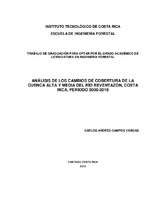Mostrar el registro sencillo del ítem
Análisis de los cambios de cobertura de la cuenca alta y media del Río Reventazón, Costa Rica, periodo 2000-2010
| dc.contributor.author | Campos-Vargas, Carlos Andrés | |
| dc.date.accessioned | 2013-02-06T19:53:20Z | |
| dc.date.available | 2013-02-06T19:53:20Z | |
| dc.date.issued | 2010 | |
| dc.identifier.uri | https://hdl.handle.net/2238/3002 | |
| dc.description | Proyecto de Graduación (Licenciatura en Ingeniería Forestal). Instituto Tecnológico de Costa Rica, Escuela de Ingeniería Forestal, 2010. | es |
| dc.description.abstract | Through ASTER satellite images was determined the coverage of the Reventazón river high and middle basins in 2010. It was found a total of 17 cover types where the forest cover type appears as the most important, covering 50% of the territory. The second most important type corresponds to pastures with a 18.1%. Moreover, the change in coverage during the period 2000–2010 was analyzed by a matrix of changes, which compared the classification made, with another carried out by the Instituto Costarricense de Electricidad in 2000. There were observed variations in all classes, where stands out the changes in water, urban and perennial categories, due to the failure of the classification of 2000. To determine the net annual exchange rate it was used the formula proposed by the United Nations Organization for Agriculture and Food, quoted by Dupuy et al (2006), where the charral type presented the highest rate of change (28.99 %). The conflicts between usability and coverage showed that 51% of the area has a proper use, 30% overuse, and 15% Subuse. The overuse stands out in the sub-Birrisito Paez, Birris, and Chiz-Maravilla. It was observed that the classes of evergreen, forest, pasture and annual crops, are the ones who presents the greatest conflicts. The potential for water erosion was estimated using Equation Universal Soil Loss (USLE) is watched by 69% of the area showed slight erosion, 14% moderate, 11% severe and 6% drastic. Established cover changes, it was assumed that the Vegetation Cover Factor (C) of the USLE, is a good indicator of potential effects on water erosion susceptibility of soils. It was found that during the study period 11% of the basin had positive changes in reducing susceptibility to erosion by changing the factor C. Due to the economic and social importance that this basin presents, knowing the cover changes and its consequences acquires major relevance, because it evaluates the effectiveness in this basin management. | es |
| dc.language.iso | es | es |
| dc.publisher | Instituto Tecnológico de Costa Rica. Escuela de Forestal | es |
| dc.rights | acceso abierto | es |
| dc.subject | Río Reventazón | es |
| dc.subject | Eledetección | es |
| dc.subject | Capacidad de uso | es |
| dc.subject | Cobertura | es |
| dc.subject | Land capacity | es |
| dc.subject | Coverage | es |
| dc.subject | Remote sensing | es |
| dc.subject | Reventazón river | es |
| dc.title | Análisis de los cambios de cobertura de la cuenca alta y media del Río Reventazón, Costa Rica, periodo 2000-2010 | es |
| dc.type | proyecto fin de carrera | es |


